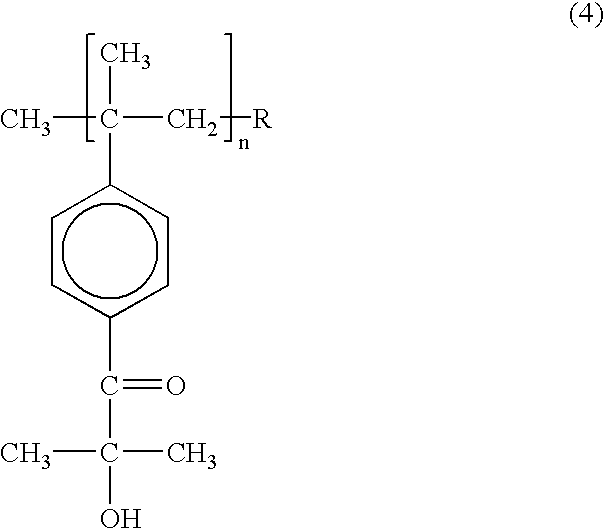Resin composition comprising particles
a technology of resin and composition, applied in the field of resin composition comprising particles, can solve the problems of large curl, low curl properties, and inability to meet the requirements of coating materials, and achieve the effects of low hardness, low friction, and large curl
- Summary
- Abstract
- Description
- Claims
- Application Information
AI Technical Summary
Benefits of technology
Problems solved by technology
Method used
Image
Examples
synthetic example 1
[0108] 20.6 parts of isophorone diisocyanate was added to a solution of 7.8 parts of mercaptopropyltrimethoxysilane and 0.2 part of dibutyl tin dilaurate in dry air in one hour while stirring at 50.degree. C. The mixture was stirred for a further three hours at 60.degree. C. After the addition of 71.4 parts of pentaerythritol triacrylate dropwise in one hour at 30.degree. C., the mixture was stirred for a further three hours at 60.degree. C. with heating to obtain an organic compound (S1). An infrared absorption spectrum of the product showed that the absorption peaks at 2550 cm.sup.-1 characteristic to a mercapto group and at 2260 cm.sup.-1 characteristic to an isocyanate group in the raw material have disappeared, and the absorption peaks at 1660 cm.sup.-1 characteristic to [--O--C(.dbd.O)--NH--] group and [--S--C(.dbd.O)--NH--] group and at 1720 cm.sup.-1 characteristic to an acryloyl group have emerged, indicating production of an organic compound (specific organic compound) hav...
synthetic example 2
[0109] 38.7 parts of 1,3-bis(isocyanatemethyl)cyclohexane was added to a solution of 38.4 parts of mercaptopropyltrimethoxysilane and 0.2 part of dibutyl tin dilaurate in dry air in one hour while stirring at 50.degree. C. The mixture was stirred for a further three hours at 70.degree. C. After the addition of 22.7 parts of 2-hydroxyethyl acrylate dropwise in one hour at 30.degree. C., the mixture was stirred for a further ten hours at 60.degree. C. with heating to obtain an organic compound (S2). The amount of isocyanate remaining in the product was analyzed to find that the remaining amount was 0.1% or less, indicating that the reaction was completed almost quantitatively.
PREPARATION OF CROSSLINKABLE PARTICLES (A)
[0110] Examples for preparing crosslinkable particles (A) are shown in Preparation Examples 1 to 4. The results are summarized in Table 1.
preparation example 1
[0111] A mixture of 8.7 parts of the organic compound (Si) synthesized in Synthetic Example 1, 91.3 parts of methyl ethyl ketone silica sol (MEK-ST, manufactured by Nissan Chemical Industries, Ltd., the number average particle diameter: 0.022 .mu.m, silica concentration: 30%), 0.2 part of iso-propanol, and 0.1 part of ion exchange water was stirred at 80.degree. C. for 3 hours in a dried air stream, followed by the addition of 1.4 parts of methyl orthoformate. The mixture was stirred for a further one hour while heating at the same temperature, to obtain a colorless transparent dispersion liquid of crosslinkable particles (A) (Dispersion Liquid "a"). 2 g of the Dispersion Liquid "a" was weighed on an aluminum dish and dried for one hour on a hot plate at 120.degree. C. The dried material was weighed to indicate that the solid content was 35%.
PUM
| Property | Measurement | Unit |
|---|---|---|
| number average particle diameter | aaaaa | aaaaa |
| number average particle diameter | aaaaa | aaaaa |
| number average particle diameter | aaaaa | aaaaa |
Abstract
Description
Claims
Application Information
 Login to View More
Login to View More - R&D
- Intellectual Property
- Life Sciences
- Materials
- Tech Scout
- Unparalleled Data Quality
- Higher Quality Content
- 60% Fewer Hallucinations
Browse by: Latest US Patents, China's latest patents, Technical Efficacy Thesaurus, Application Domain, Technology Topic, Popular Technical Reports.
© 2025 PatSnap. All rights reserved.Legal|Privacy policy|Modern Slavery Act Transparency Statement|Sitemap|About US| Contact US: help@patsnap.com



